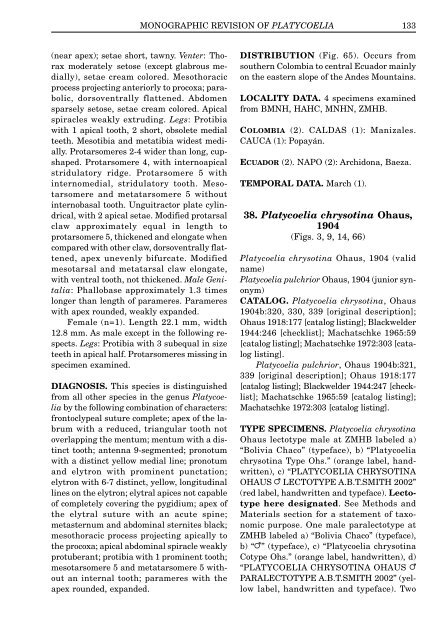Download full text (PDF 4.5 MB) - University of Nebraska State ...
Download full text (PDF 4.5 MB) - University of Nebraska State ...
Download full text (PDF 4.5 MB) - University of Nebraska State ...
You also want an ePaper? Increase the reach of your titles
YUMPU automatically turns print PDFs into web optimized ePapers that Google loves.
MONOGRAPHIC REVISION OF PLATYCOELIA 133<br />
(near apex); setae short, tawny. Venter: Thorax<br />
moderately setose (except glabrous medially),<br />
setae cream colored. Mesothoracic<br />
process projecting anteriorly to procoxa; parabolic,<br />
dorsoventrally flattened. Abdomen<br />
sparsely setose, setae cream colored. Apical<br />
spiracles weakly extruding. Legs: Protibia<br />
with 1 apical tooth, 2 short, obsolete medial<br />
teeth. Mesotibia and metatibia widest medially.<br />
Protarsomeres 2-4 wider than long, cupshaped.<br />
Protarsomere 4, with internoapical<br />
stridulatory ridge. Protarsomere 5 with<br />
internomedial, stridulatory tooth. Mesotarsomere<br />
and metatarsomere 5 without<br />
internobasal tooth. Unguitractor plate cylindrical,<br />
with 2 apical setae. Modified protarsal<br />
claw approximately equal in length to<br />
protarsomere 5, thickened and elongate when<br />
compared with other claw, dorsoventrally flattened,<br />
apex unevenly bifurcate. Modified<br />
mesotarsal and metatarsal claw elongate,<br />
with ventral tooth, not thickened. Male Genitalia:<br />
Phallobase approximately 1.3 times<br />
longer than length <strong>of</strong> parameres. Parameres<br />
with apex rounded, weakly expanded.<br />
Female (n=1). Length 22.1 mm, width<br />
12.8 mm. As male except in the following respects.<br />
Legs: Protibia with 3 subequal in size<br />
teeth in apical half. Protarsomeres missing in<br />
specimen examined.<br />
DIAGNOSIS. This species is distinguished<br />
from all other species in the genus Platycoelia<br />
by the following combination <strong>of</strong> characters:<br />
frontoclypeal suture complete; apex <strong>of</strong> the labrum<br />
with a reduced, triangular tooth not<br />
overlapping the mentum; mentum with a distinct<br />
tooth; antenna 9-segmented; pronotum<br />
with a distinct yellow medial line; pronotum<br />
and elytron with prominent punctation;<br />
elytron with 6-7 distinct, yellow, longitudinal<br />
lines on the elytron; elytral apices not capable<br />
<strong>of</strong> completely covering the pygidium; apex <strong>of</strong><br />
the elytral suture with an acute spine;<br />
metasternum and abdominal sternites black;<br />
mesothoracic process projecting apically to<br />
the procoxa; apical abdominal spiracle weakly<br />
protuberant; protibia with 1 prominent tooth;<br />
mesotarsomere 5 and metatarsomere 5 without<br />
an internal tooth; parameres with the<br />
apex rounded, expanded.<br />
DISTRIBUTION (Fig. 65). Occurs from<br />
southern Colombia to central Ecuador mainly<br />
on the eastern slope <strong>of</strong> the Andes Mountains.<br />
LOCALITY DATA. 4 specimens examined<br />
from BMNH, HAHC, MNHN, ZMHB.<br />
COLO<strong>MB</strong>IA (2). CALDAS (1): Manizales.<br />
CAUCA (1): Popayán.<br />
ECUADOR (2). NAPO (2): Archidona, Baeza.<br />
TEMPORAL DATA. March (1).<br />
38. Platycoelia chrysotina Ohaus,<br />
1904<br />
(Figs. 3, 9, 14, 66)<br />
Platycoelia chrysotina Ohaus, 1904 (valid<br />
name)<br />
Platycoelia pulchrior Ohaus, 1904 (junior synonym)<br />
CATALOG. Platycoelia chrysotina, Ohaus<br />
1904b:320, 330, 339 [original description];<br />
Ohaus 1918:177 [catalog listing]; Blackwelder<br />
1944:246 [checklist]; Machatschke 1965:59<br />
[catalog listing]; Machatschke 1972:303 [catalog<br />
listing].<br />
Platycoelia pulchrior, Ohaus 1904b:321,<br />
339 [original description]; Ohaus 1918:177<br />
[catalog listing]; Blackwelder 1944:247 [checklist];<br />
Machatschke 1965:59 [catalog listing];<br />
Machatschke 1972:303 [catalog listing].<br />
TYPE SPECIMENS. Platycoelia chrysotina<br />
Ohaus lectotype male at ZMHB labeled a)<br />
“Bolivia Chaco” (typeface), b) “Platycoelia<br />
chrysotina Type Ohs.” (orange label, handwritten),<br />
c) “PLATYCOELIA CHRYSOTINA<br />
OHAUS M LECTOTYPE A.B.T.SMITH 2002”<br />
(red label, handwritten and typeface). Lectotype<br />
here designated. See Methods and<br />
Materials section for a statement <strong>of</strong> taxonomic<br />
purpose. One male paralectotype at<br />
ZMHB labeled a) “Bolivia Chaco” (typeface),<br />
b) “M” (typeface), c) “Platycoelia chrysotina<br />
Cotype Ohs.” (orange label, handwritten), d)<br />
“PLATYCOELIA CHRYSOTINA OHAUS M<br />
PARALECTOTYPE A.B.T.SMITH 2002” (yellow<br />
label, handwritten and typeface). Two
















